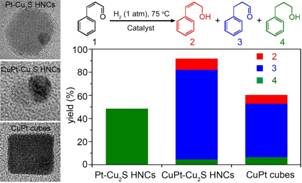The research group of Prof. ZENG Jie from University of Science and Technology of China made new progress in the controlled synthesis and growth mechanism study of metal-sulfide. In their work, through simply changing the Pt precursor types, Zeng and co-workers developed a one-pot synthesis of CuPt-Cu2S, Pt-Cu2S HNCs, and CuPt nanocubeswith controllablemorphology and compositionandsuccessfully tunedtheir catalytic activitiy and selectivity. The work has been published on Nano letters (Nano Lett. 2014, 14, 6666-6671) with the title of One-step Synthesis of Hybrid Nanocrystals with Rational Tuning of the Morphology”.
Metal-semiconductor hybrid nanocrystals (HNCs) consisting of both metal and semiconductor sections that are joint through direct contact are mostly distinguished by their interfacial effect.In the case of metal-sulfide HNCs, specifically, charge transfer between metal and sulfide can modify the electronic structure and band alignment of both domains and thus may improve their properties.Based on previous works on the controlled synthesis of nanostructures and inspired by classical theories of crystal growth, they mediated the reduction potential of Pt ions and the reduction sequences of two metal precursors by changing Pt precursor types and taking advantage of the different coordination abilities of 1-hexadecanethiol toward different Pt precursors. In the experiment of cinnamaldehyde hydrogenation, Pt-Cu2S HNCs simultaneously hydrogenated both the olefinic and carbonyl groups. Whereas the other two CuPt-containing NCs which are endowed with the synergistic function of Cu and Pt, were chemoselective for the reduction of olefinic group. Besides, the higher selectivity of CuPt-Cu2S HNCs toward hydrocinnamaldehyde relative to CuPt NCs was probably attributed to the interfacial effect. This work will provide the tool box for future endeavors in the fabrication of functional complex nanostructures.

Conversion of the reduction of cinnamaldehyde catalyzed by Pt-Cu2S, CuPt and CuPt-Cu2S nanocrystals.
This work was supported by 973 Program, NSFC, Recruitment Program of Global Experts, CAS Hundred Talent Program, and Fundamental Research Funds for the Central Universities.
Link to the paper: http://pubs.acs.org/doi/abs/10.1021/nl503343n